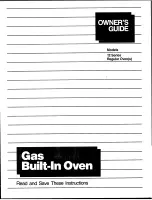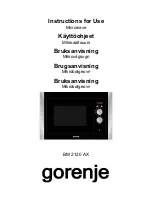
18
19
General guidelines
Dish size
Follow the dish sizes given in
the recipes, as these affect the
cook ing and reheating times .
A quan tity of food spread in a
bigger dish cooks and reheats
more quickly .
Quantity
Small quantities cook faster
than large quantities, also small
meals will reheat more quickly
than large portions .
Spacing
Foods cook more quickly and
evenly if spaced apart . NEVER
pile foods on top of each other .
Shape
Even shapes cook evenly .
Food cooks better by
microwave when in a round
container rather than square .
Density
Porous airy foods heat more
quickly than dense heavy
foods .
Covering
Cover foods with microwave
cling film or a self-fitting lid.
Cover fish, vegetables,
cas seroles, soups . Do not
cover cakes, sauces, jacket
potatoes, pastry items .
Arranging
Individual foods e .g . chicken
portions or chops, should be
placed on a dish so that the
thicker parts are to the outside .
Starting temperature
The colder the food, the longer
it takes to heat up . Food from
a fridge takes longer to reheat
than food at room temperature .
Food temperature should be
between 5-8ºC before cooking .
Turning and stirring
Some foods require stirring
during cooking . Meat and
poultry should be turned after
half the cooking time .
Liquids
All liquids must be stirred
before, during and after
heating . Water espe cially must
be stirred before and during
heating, to avoid eruption .
Do not heat liquids that have
previously been boiled .
DO NOT OVERHEAT .
Checking food
It is essential that food is
checked during and after a
recommended cooking time,
even if an AUTO PROGRAM
has been used (just as you
would check food cooked in a
conven tional oven) . Return
the food to the oven for further
cooking if necessary .
Cleaning
As microwaves work on food
particles, keep your oven clean
at all times . Wipe with a soft
damp cloth, always wipe the
oven dry after cleaning . Avoid
any plastic parts, the roof of the
oven and door area .
















































